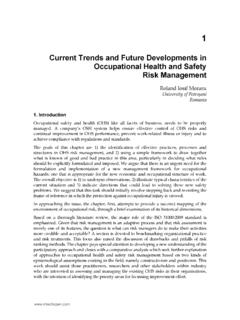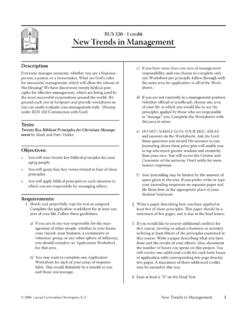Transcription of “Human Resources management strategies to …
1 Minist re de la Fonction publique et de la R forme administrative PricewaterhouseCoopers human Resources management strategies to support organizational changes Luxembourg, June 2005 Survey for the 44th meeting of the Directors general responible for Public Administration of the EU member states 2 Table of contents 1. Introduction_____ 6 Context _____ 6 Methodology and participants _____ 6 Report format _____ 7 2.
2 HR Strategies_____ 8 HR strategies_____ 9 Government strategies _____ 15 Alignment gap _____ 18 3. HR Organization _____ 20 4. HR Processes and Practices _____ 23 Recruitment _____ 23 Career management _____ 32 5. HR Services and Information Technology _____ 41 HR Services _____ 41 HR technology_____ 42 6. Conclusion _____ 44 7. Appendices_____ 47 3 Executive Summary This report outlines some key issues surrounding the field of human resource management in EU member states.
3 The study has been conducted in the human Resources Working Group (HRWG) under the Luxembourg Presidency of the European Union. It aims at getting a picture on current human Resources (HR) management strategies , practices and outcomes. The issue of human Resources strategies to support organizational changes is vast. Therefore, this report does not claim to address all of the issues related to how much value people add to an organisation. Nonetheless, it is an attempt to share key findings between EU member states.
4 Furthermore it would be sensible if the study could be completed and enriched in future EU presidencies. The main issues are briefly detailed below, along 3 main parts: Strategy HR strategies : In HR literature, a number of various models and approaches try to demonstrate how a strategic approach to HR can be translated into a set of coherent HR processes and practices. These models have value in highlighting some fundamental issues and demonstrating the importance of a strategic approach.
5 However, they are generally focused on the development of HR strategies with an implicit assumption that the organization is relatively autonomous in developing its own strategy. According to the survey results, HR strategies are generally aligned with governmental strategies , supporting to a certain extent the organizational changes. Yet, in the public sector, HR strategy is not autonomous and needs to take into account a range of different stakeholder perspectives and to be focused at national level as well as lower local level.
6 Thus, the results of this study give positive information on a general national perspective, where we see that HR strategies are people oriented , formalized and aligned with government strategies . However, on the level of the various local administrations (not tackled in this survey), HR strategies formulated on a central level might be distant from the actual HR processes and practices in place. In other words, HR might be in line with certain government strategies on a more conceptual level, yet, at a local level, these strategies are not automatically developed.
7 It is the ability to build a strategy appropriate to local requirements and to implement it effectively that is also essential. It would be interesting to look more closely at this important issue in future EU surveys. Furthermore, the survey shows that although HR strategies are aligned with government strategies , HR is not yet a generator of changes. The HR function does not anticipate on its agenda important social or economical changes like for instance demographic changes.
8 Operational - HR processes and practices: By looking at the operational side of the HR function, the report details that HR services in the public sector are going through an ongoing evolution and modernization. HR actors have realized how important the people issue is. Numerous and various types of HR projects are led and planned in order to improve the HR function, its processes and practices. 4 Furthermore, the survey addressed more particularly recruitment and career management processes.
9 Various aspects of these 2 HR processes have been explored, where we see strong public sector specificities combined with the use of new HR methods and tools. For instance, in the recruitment process, written and oral examinations are still very important to ensure transparency and equality for all citizens to apply for a job. However, methods such as behavioral tests, assessment centers, job databases are being developed and used. On that point again, the EU member states gave the information they had on their national level.
10 Therefore, the global picture on how these processes are practiced on a local level is still missing. Additionally, in order to bring some more tangible and measurable information on how the operational side of HR creates value and is aligned with government strategies , other key questions would have to be addressed in the future such as: What are the most appropriate measures of effectiveness for the public sector HR function? On what does HR services actually report?










